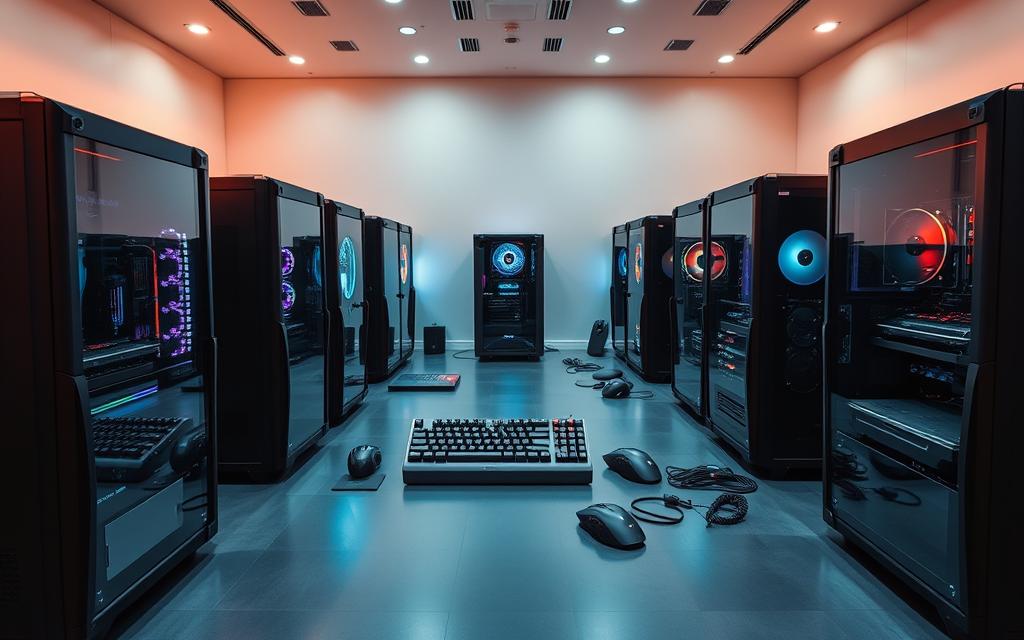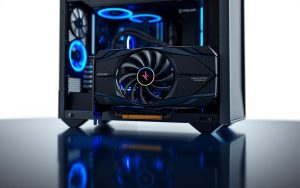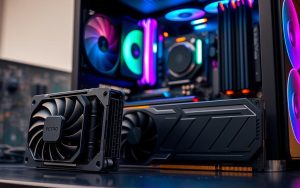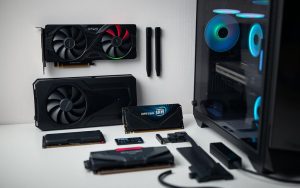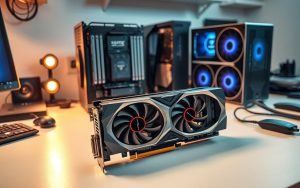Table of Contents
Choosing the right gaming PC requires careful consideration. With the rise of PC gaming, it’s crucial to make informed decisions to get the best value. Performance and budget are key factors to balance when selecting components.
Key hardware like the GPU, CPU, and RAM significantly impact your gaming experience. Cooling systems and power supplies ensure stability during intense sessions. Storage options and connectivity features also play a vital role in long-term usability.
PC gaming has gained popularity over consoles like the PS5 and Xbox Series X. Investing in future-proof hardware ensures your system stays relevant for years. By focusing on these essentials, you can build or buy a gaming PC that meets your needs.
Introduction: Why a Gaming PC is Worth the Investment
Modern gaming rigs provide more than just entertainment—they redefine versatility. With 4K/120fps capabilities, these systems outperform consoles, delivering smoother visuals and faster response times. Whether you’re exploring open worlds or competing in esports, the difference is undeniable.
The pandemic amplified their role as social hubs. Platforms like Discord and multiplayer games such as World of Warcraft turned rigs into virtual gathering spaces. Unlike consoles, PCs seamlessly blend play with productivity:
- Streaming: Broadcast gameplay or host meetings without lag.
- Content creation: Edit videos or design graphics with high-end software.
- Home office: Multitask across work and leisure effortlessly.
Despite supply chain challenges, component prices have stabilized. Sites like PCPartPicker track trends, helping you maximize value. While upgrades every 2 years keep performance peak, a well-built system can last a decade.
From unmatched graphics to multitasking muscle, gaming setups are a smart use of money and time. They evolve with your needs, ensuring relevance for years.
What to Know Before Buying a Gaming PC: Key Considerations
The right components can make or break your gaming experience. Whether you’re building from scratch or opting for a prebuilt system, understanding the interplay between hardware is essential.
Prebuilt PCs now offer better value, often including warranties and support. However, DIY builds allow for customization and potential cost savings. MicroCenter bulk discounts can make DIY more affordable, but prebuilt systems save time and effort.
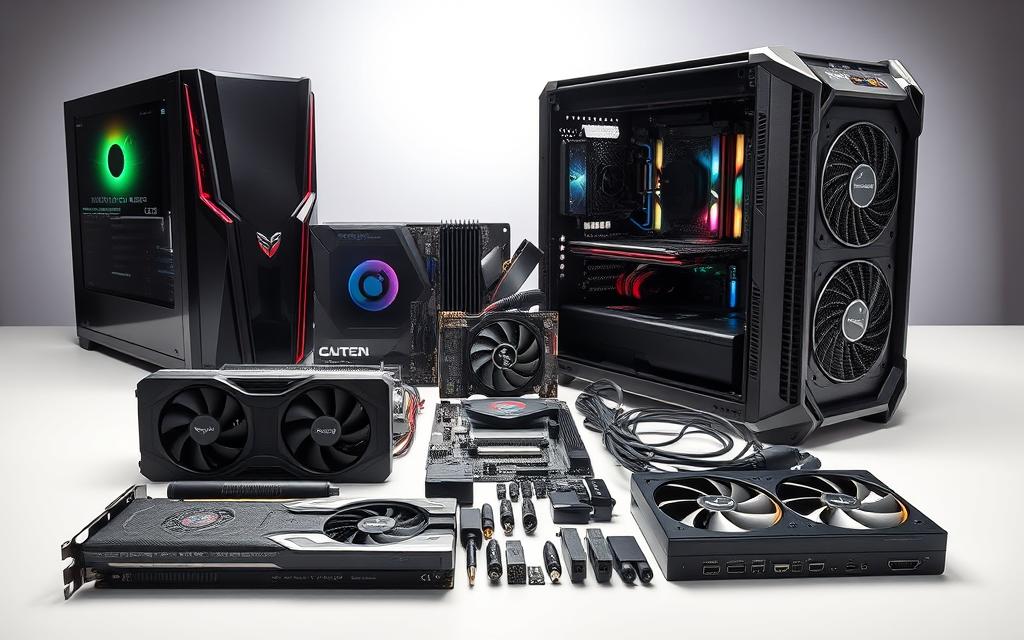
When selecting a system, prioritize performance over aesthetics. A powerful graphics card and CPU are more critical than RGB lighting. For modern titles, aim for at least 12GB GDDR6 VRAM to ensure smooth gameplay.
“The GPU and CPU must work in harmony to avoid bottlenecks, ensuring optimal performance.”
Here’s a quick comparison of prebuilt vs. DIY builds:
| Feature | Prebuilt | DIY |
|---|---|---|
| Cost | Higher upfront | Potentially lower |
| Customization | Limited | Full control |
| Support | Included | Self-reliant |
Peripheral compatibility is another key factor. Ensure your system supports USB-C and DisplayPort for modern monitors and accessories. Balancing budget and hardware ensures a future-proof setup that meets your needs.
Choosing the Right GPU for Optimal Performance
Your gaming experience hinges on the quality of your GPU. This component drives visuals, ensuring smooth gameplay and stunning graphics. Whether you’re exploring vast open worlds or competing in fast-paced esports, the right graphics card makes all the difference.
Why the GPU is the Heart of Your Gaming PC
The GPU handles rendering, transforming data into the images you see on screen. A powerful GPU ensures high frame rates and crisp visuals, even at 4K resolution. For modern titles, VRAM is crucial—12GB or more prevents stuttering in demanding games.
Nvidia vs. AMD: Which GPU is Right for You?
Nvidia’s RTX 40-Series excels in ray tracing and DLSS 3.0, offering superior upscaling. The RTX 4090 handles 4K/120fps effortlessly, while the RTX 4060 is ideal for 1440p gaming. AMD’s Radeon RX 7000 series provides competitive performance at lower price points, making it a strong alternative.
“The GPU and CPU must work in harmony to avoid bottlenecks, ensuring optimal performance.”
Future-Proofing Your System with the Right GPU
Investing in a high-end graphics card ensures your system remains relevant for years. Consider thermal design power (TDP) to ensure compatibility with your case. EVGA FTW3 Ultra cooling solutions are excellent for overclocking, maximizing performance without overheating.
Here’s a quick comparison of Nvidia and AMD GPUs:
- Nvidia RTX 40-Series: Superior ray tracing and DLSS 3.0 support.
- AMD Radeon RX 7000: Competitive price-to-performance ratios.
- VRAM: 12GB+ recommended for AAA titles.
Balancing performance and budget ensures your gaming rig delivers the best experience. Whether you choose Nvidia or AMD, prioritize features that align with your gaming needs.
Don’t Overlook the Importance of a Powerful CPU
A powerful CPU is the backbone of any high-performance gaming rig. It handles everything from game physics to AI calculations, ensuring smooth gameplay. Without a capable processor, even the best GPU can’t reach its full potential.
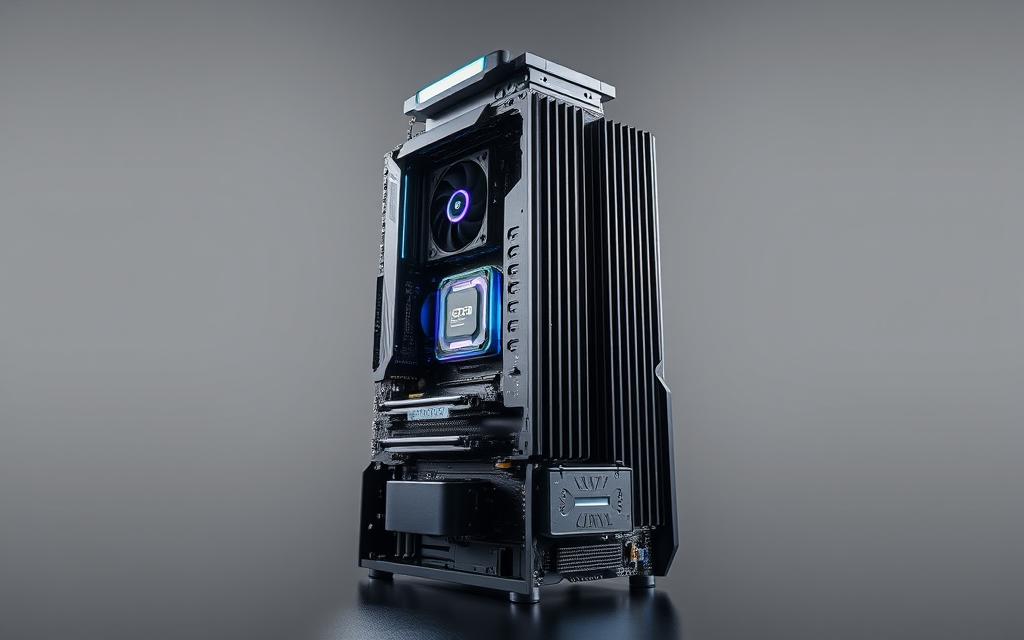
How the CPU Impacts Gaming Performance
The CPU determines how quickly your system processes data. High core counts and clock speeds improve multitasking and reduce lag. For modern games, a balance between cores and speed is essential.
Games like Cyberpunk 2077 and Starfield demand both single-threaded and multi-threaded performance. A powerful CPU ensures your system can handle these demands without bottlenecks.
Top CPU Picks for Gamers: AMD Ryzen vs. Intel Core
The AMD Ryzen 7 9800X3D leads gaming benchmarks with its 3D V-Cache technology. It’s ideal for gamers seeking top-tier performance. On the other hand, the Intel Core i5-13400 offers excellent value for budget-conscious builders.
Here’s a quick comparison:
- AMD Ryzen 7000 Series: Supports PCIe 5.0 and offers Smart Access Memory for AMD GPU combos.
- Intel Core 13th Gen: Features hybrid architecture for efficient multitasking.
Ensuring Compatibility Between CPU and Motherboard
Matching your CPU with the right motherboard is crucial. AMD’s AM5 socket and Intel’s LGA 1700 require specific boards. Always check compatibility before purchasing.
Installation tips:
- Align the CPU carefully to avoid bent pins.
- Use thermal paste for better heat transfer.
- Consider the Noctua NH-D15 cooler for high-TDP processors.
“A well-matched CPU and motherboard ensure stability and future-proof your build.”
By focusing on these factors, you can maximize your gaming rig’s performance and longevity.
Motherboard Matters: The Backbone of Your Gaming PC
Every component in your rig connects through one critical piece of hardware. The motherboard dictates your system’s upgrade potential, performance ceiling, and compatibility with future tech. Choosing wisely ensures your build remains relevant for years.
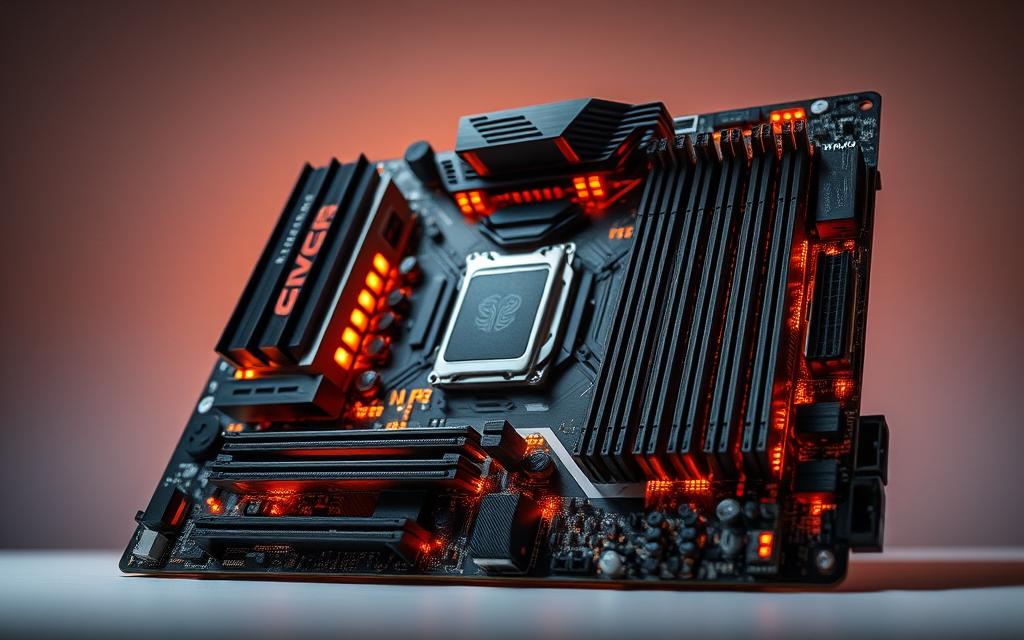
Key Features to Look for in a Gaming Motherboard
Voltage Regulator Module (VRM) quality is non-negotiable. High-end VRMs deliver stable power to your CPU, especially during overclocking. Look for heatsinks and 12+2 phase designs in boards like the ASUS ROG Strix.
DDR5 support is essential for next-gen builds. Chipsets like Intel’s Z790 and AMD’s X670E offer faster memory speeds. Pair them with low-latency RAM for optimal performance.
“PCIe 5.0 lanes are critical for next-gen GPUs and NVMe SSDs, ensuring no bandwidth bottlenecks.”
Compatibility and Future-Proofing Your Build
Match your motherboard’s socket type to your CPU. Intel’s LGA 1700 and AMD’s AM5 require specific chipsets. BIOS flashback features let you update firmware without a compatible CPU installed.
For storage, prioritize boards with dual M.2 slots. RAID configurations boost speed, while PCIe 5.0 ensures readiness for upcoming SSDs. The MSI MAG Tomahawk excels here with its balanced feature set.
Choosing the Right Form Factor for Your Needs
Form factor impacts expandability and case fit. Consider these options:
| Type | Size | Best For |
|---|---|---|
| ATX | 12″ x 9.6″ | Full builds with multiple GPUs |
| MicroATX | 9.6″ x 9.6″ | Compact setups with fewer expansions |
| Mini-ITX | 6.7″ x 6.7″ | Portable, space-constrained rigs |
For more details on selecting essential components for building a gaming, explore our guide.
Keeping Your System Cool: The Role of the PC Case
A well-designed PC case is more than just a shell—it’s a critical component for maintaining system health. Proper cooling ensures your hardware runs efficiently, preventing overheating and extending its lifespan. The right case design can significantly impact performance, especially during intense gaming sessions.
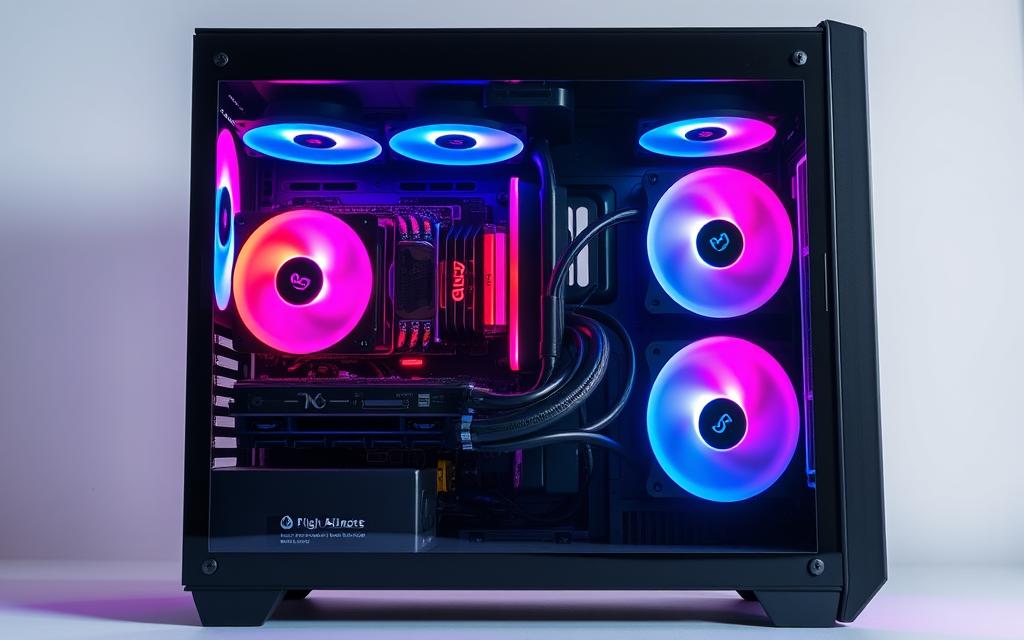
Why Airflow is Crucial for Gaming PCs
Effective airflow is essential for keeping temperatures in check. A case with a mesh front allows better air intake compared to tempered glass designs. Positive air pressure setups reduce dust buildup, keeping your components cleaner and cooler.
Vertical GPU mounting can improve aesthetics but may restrict airflow. Always consider the tradeoffs between design and functionality. RGB lighting adds flair but can increase internal temperatures if not managed properly.
Top PC Case Recommendations for Optimal Cooling
Here are some top picks for cases that excel in cooling:
- MSI MPG Gungnir 300R: Features a 6-fan configuration for maximum airflow.
- Lian Li O11 Dynamic EVO: Offers hybrid liquid/air cooling for superior temperature control.
- NZXT H7 Flow: Known for its excellent airflow metrics and sleek design.
- Corsair 4000D: Combines performance and affordability with a focus on cooling.
Balancing Aesthetics and Functionality in Your Case
While a visually appealing case is desirable, prioritize functionality. Mesh-front designs often outperform tempered glass in thermal performance. Ensure your case supports your build’s cooling needs while complementing your setup’s style.
By focusing on airflow and cooling, you can maintain optimal performance and protect your hardware. A well-chosen case is an investment in your system’s longevity and efficiency.
Future-Proof Your Gaming PC with a Reliable PSU
A reliable power supply unit (PSU) is the unsung hero of any high-performance gaming rig. It ensures your components receive stable power, preventing crashes and extending longevity. Choosing the right PSU is crucial for both performance and safety.
Understanding Power Supply Requirements
Your PSU must match your system’s demands. High-end GPUs like the RTX 4090 require at least 850W, while mid-range builds can function with 650W. Always calculate your total wattage needs by adding your GPU’s TDP and an additional 30% buffer.
Single-rail designs are ideal for high-wattage GPUs, delivering consistent power. Multi-rail setups offer safety but may limit performance. Modular PSUs improve airflow and cable management, making them a popular choice for builders.
Choosing the Right Wattage for Your Build
For NVIDIA’s RTX 40-Series, 750W is sufficient for the 4070, while the 4090 demands 1000W. AMD’s Radeon RX 7000 series has similar requirements. Use online calculators or refer to detailed guides to determine your exact needs.
Here’s a quick reference for popular GPUs:
- RTX 4070: 750W
- RTX 4080: 850W
- RTX 4090: 1000W
Why a Quality PSU is Essential for Longevity
Investing in a high-quality PSU ensures your system remains stable under heavy loads. Look for 80 Plus Gold certification or higher, which guarantees efficiency and reliability. Brands like Seasonic PRIME and Corsair RMx are known for their durability.
“A quality PSU not only powers your system but also protects it from voltage spikes and surges.”
Avoid daisy-chaining PCIe power connectors, as this can overload the PSU. Instead, use dedicated cables for each connection. By prioritizing a reliable PSU, you safeguard your investment and ensure peak performance for years.
RAM and Storage: Finding the Right Balance
Balancing RAM and storage is critical for a smooth gaming experience. These components work together to ensure fast load times, seamless multitasking, and optimal performance. Choosing the right combination can make a significant difference in your gameplay.
How Much RAM Do You Really Need for Gaming?
Modern games demand more memory than ever before. For most gamers, 16GB of RAM is the sweet spot, providing enough headroom for multitasking and demanding titles. However, if you’re into content creation or streaming, 32GB is a better choice.
DDR5-6000 offers lower latency and faster speeds compared to DDR4-3200. While the performance boost is noticeable, the price difference may not justify the upgrade for casual gamers. Here’s a quick comparison:
| Type | Speed | Latency |
|---|---|---|
| DDR4-3200 | 3200 MHz | Higher |
| DDR5-6000 | 6000 MHz | Lower |
SSD vs. HDD: Choosing the Right Storage Solution
When it comes to storage, SSDs are the clear winner for gaming. They offer faster load times and better performance, especially with technologies like DirectStorage API. The WD Black SN850X is a top pick for gamers, delivering blazing-fast speeds.
While HDDs are more affordable, they’re slower and less reliable for gaming. A hybrid setup with a 1TB SSD for games and a 4TB HDD for media files strikes a perfect balance between speed and capacity.
“RAID 0 configurations can double SSD speeds, but they come with increased risk of data loss.”
Future-Proofing Your System with Adequate Storage
As game sizes continue to grow, having enough storage is essential. PCIe 4.0 SSDs offer double the bandwidth of SATA drives, making them ideal for future-proofing. With 2TB SSD prices dropping 40% YoY, now is the perfect time to upgrade.
Here’s a quick guide to storage options:
- PCIe 4.0 SSD: Best for gaming and future-proofing.
- SATA SSD: Affordable and reliable for older systems.
- HDD: Ideal for bulk storage and backups.
By focusing on the right balance of RAM and storage, you can ensure your gaming rig performs at its best for years to come.
Port Selection and Connectivity: Enhancing Your Gaming Experience
The right ports and connectivity options can elevate your gaming setup to the next level. Modern gaming demands seamless integration of devices, from monitors to VR headsets. Ensuring your system has the right inputs and outputs is essential for a smooth experience.
Why Port Selection Matters for Gamers
Ports determine how you connect your peripherals and external devices. High-speed USB-C and HDMI 2.1 enable 4K/120Hz displays, offering crisp visuals and smooth gameplay. Without the right ports, even the best hardware can fall short.
Thunderbolt 4 support is another game-changer. It allows for external GPU enclosures, expanding your system’s capabilities. This is especially useful for gamers who need extra power for demanding titles.
Key Ports to Look for in a Gaming PC
When selecting a system, prioritize these essential ports:
- USB 3.2 Gen2x2: Offers 20Gbps throughput, ideal for fast data transfer.
- HDMI 2.1: Supports 4K/120Hz and Variable Refresh Rate (VRR) for smoother visuals.
- DisplayPort 2.1: Provides higher bandwidth for future-proofing.
- Front-panel USB-C: Essential for VR headsets and quick device access.
Connecting Peripherals for a Seamless Experience
Wireless peripherals offer convenience but can introduce latency. For competitive gaming, wired connections are more reliable. Anker USB-C hubs are excellent for multi-device setups, ensuring all your gear stays connected.
“HDMI 2.1 enables 4K/120Hz on monitors, delivering unmatched clarity and responsiveness.”
By focusing on the right ports and connectivity, you can create a gaming rig that meets all your needs. Whether you’re streaming, competing, or exploring virtual worlds, the right setup makes all the difference.
Conclusion: Making an Informed Decision on Your Gaming PC
Building or selecting a high-performance system requires understanding key components and their roles. Prioritize the GPU for visuals, followed by the CPU for processing power. A reliable PSU and efficient cooling ensure stability and longevity.
Prebuilt systems often include warranties and support, offering peace of mind. For DIY builds, plan a 3-year upgrade cycle for GPUs and 5 years for PSUs. This approach balances budget and performance while future-proofing your setup.
First-time buyers should focus on a final checklist: compatibility, cooling, and connectivity. For detailed GPU comparisons, refer to Tom’s Guide hierarchy charts. By making informed decisions, you can create a system that meets your needs and lasts for years.
FAQ
Why is the GPU considered the most important component in a gaming PC?
The GPU, or graphics card, handles rendering visuals, directly impacting frame rates and overall gaming performance. A powerful GPU ensures smoother gameplay and better graphics quality.
How do I choose between Nvidia and AMD GPUs?
Nvidia GPUs often excel in ray tracing and DLSS technology, while AMD offers competitive performance at lower prices. Consider your budget and the types of games you play to decide.
What role does the CPU play in gaming performance?
The CPU manages game logic, physics, and AI. A strong processor, like AMD Ryzen or Intel Core, ensures your system can handle demanding games without bottlenecks.
How much RAM is sufficient for modern gaming?
16GB of RAM is the sweet spot for most gamers, providing enough memory for smooth multitasking and gaming. However, 32GB is recommended for future-proofing or heavy workloads.
Should I choose an SSD or HDD for storage?
SSDs offer faster load times and better performance, making them ideal for gaming. HDDs are more affordable for bulk storage but are slower. A combination of both is often the best solution.
What should I look for in a gaming motherboard?
Ensure compatibility with your CPU and GPU, sufficient RAM slots, and support for future upgrades. Features like PCIe 4.0 and USB-C ports can enhance your build’s longevity.
Why is airflow important in a PC case?
Proper airflow prevents overheating, ensuring your components run efficiently and last longer. Look for cases with multiple fans and good ventilation.
How do I determine the right PSU wattage for my build?
Calculate the total power consumption of your components and add a 20-30% buffer. A quality PSU with 80 Plus certification ensures reliability and efficiency.
What ports are essential for a gaming PC?
Look for USB 3.0/3.1, HDMI, DisplayPort, and audio jacks. These ports ensure compatibility with peripherals like monitors, keyboards, and headsets.
How can I future-proof my gaming PC?
Invest in a powerful GPU, CPU, and ample RAM. Choose components with upgrade potential, like a motherboard with extra PCIe slots and a PSU with higher wattage.


